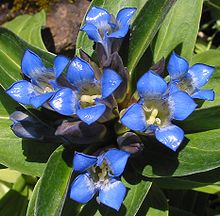Gentianales
| Gentianales | |
|---|---|

| |
| Gentiana cruciata | |
| Scientific classification | |
| Kingdom: | Plantae |
| Clade: | Tracheophytes |
| Clade: | Angiosperms |
| Clade: | Eudicots |
| Clade: | Asterids |
| Clade: | Lamiids |
| Order: | Gentianales Juss. ex Bercht. & J.Presl |
| Families | |
| Synonyms | |
Gentianales is an order of flowering plants, included within the asterid clade of eudicots. It comprises more than 20,000 species in about 1,200 genera in 5 families.[1] More than 80% of the species in this order belong to the family Rubiaceae.
Many of these flowering plants are used in traditional medicine.[2] They have been used to treat pain, anxiety, cancers and neurological conditions.
Honeybees are a well known pollinator of Gentianales species in Brazil.[3]
Taxonomy[]
In the classification system of Dahlgren the Gentiales were in the superorder Gentianiflorae (also called Gentiananae). The following families are included according to the APG III system:[4]
- Family Apocynaceae (424 genera)
- Family Gelsemiaceae (2 genera)
- Family Gentianaceae (87 genera)
- Family Loganiaceae (13 genera)
- Family Rubiaceae (611 genera)
Phylogeny[]
The following phylogenetic tree is based on molecular phylogenetic studies of DNA sequences.[5]
| Gentianales |
| ||||||||||||||||||||||||
Etymology[]
It takes its name from the family Gentianaceae, which in turn is based on the name of the type genus, Gentiana. The genus name is a tribute to Gentius, an Illyrian king.
Uses[]
Well-known members of Gentianales are coffee, frangipani, Gardenia, gentian, oleander, and periwinkle.
Some Gentianales species have been used in traditional medicine in rural southeastern Asia countries. Gelsemium sempervirens has been used in Chinese medicine in conditions such as anxiety, migraines/headaches, and neuralgia. Gelsemium elegans has been used in rheumatoid arthritis pain, neuropathic pain, skin ulcers, and even cancers.[2]
References[]
| Wikimedia Commons has media related to Gentianales. |
| Wikispecies has information related to Gentianales. |
- ^ Yang, Lei-Lei; Li, Hong-Lei; Wei, Lei; Yang, Tuo; Kuang, Dai-Yong; Li, Ming-Hong; Liao, Yi-Ying; Chen, Zhi-Duan; Wu, Hong; Zhang, Shou-Zhou (July 2016). "A supermatrix approach provides a comprehensive genus-level phylogeny for Gentianales: Phylogeny of Gentianales". Journal of Systematics and Evolution. 54 (4): 400–415. doi:10.1111/jse.12192.
- ^ Jump up to: a b Jin, Gui-Lin; Su, Yan-Ping; Liu, Ming; Xu, Ying; Yang, Jian; Liao, Kai-Jun; Yu, Chang-Xi (February 2014). "Medicinal plants of the genus Gelsemium (Gelsemiaceae, Gentianales)—A review of their phytochemistry, pharmacology, toxicology and traditional use". Journal of Ethnopharmacology. 152 (1): 33–52. doi:10.1016/j.jep.2014.01.003. PMID 24434844.
- ^ Hipolito, J (2020). "Performance, Effectiveness, and Efficiency of Honeybees as Pollinators of Coffea arabica (Gentianales, Rubiaceae)". Neotropical Entomology. 49 (4): 501–510. doi:10.1007/s13744-020-00785-8. PMID 32691402. S2CID 220638532 – via Web of Science.
- ^ Angiosperm Phylogeny Group (2009). "An update of the Angiosperm Phylogeny Group classification for the orders and families of flowering plants: APG III". Botanical Journal of the Linnean Society. 161 (2): 105–121. doi:10.1111/j.1095-8339.2009.00996.x.
- ^ Backlund M, Oxelman B, Bremer B (2000). "Phylogenetic relationships within the Gentianales based on NDHF and RBCL sequences, with particular reference to the Loganiaceae". American Journal of Botany. 87 (7): 1029–1043. doi:10.2307/2657003. JSTOR 2657003. PMID 10898781. S2CID 15433433.
- Gentianales
- Angiosperm orders
- Gentianales stubs

